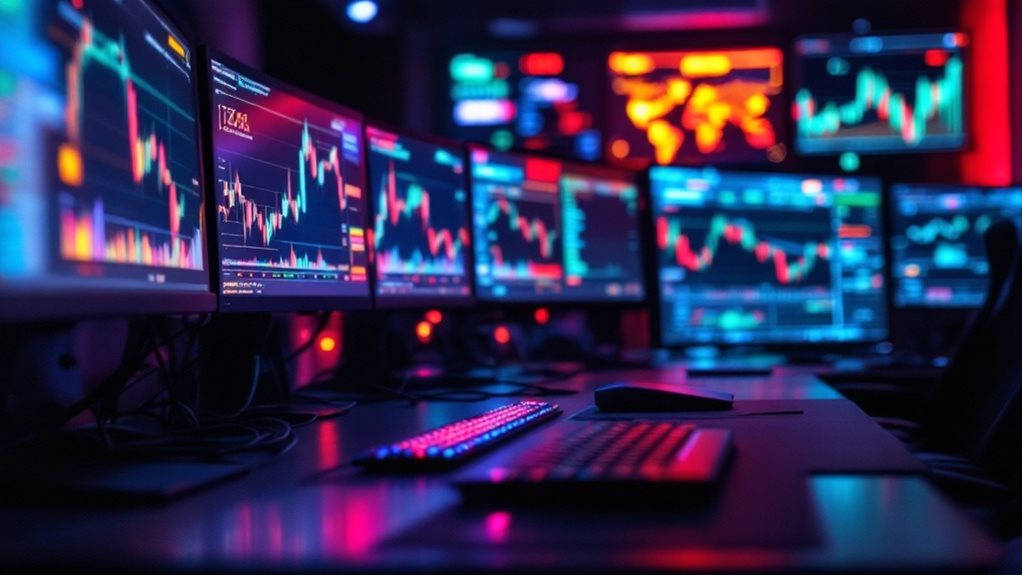Cryptocurrency trading happens on digital exchanges like Binance and Coinbase. Traders first create accounts and deposit funds to start buying and selling virtual currencies. The process works similarly to stock trading but operates entirely online through trading pairs. Users can choose different methods, including spot trading for immediate transactions or derivatives for speculating on price movements. The crypto market's unique features and strategies offer various ways to participate in this digital financial ecosystem.

Cryptocurrency trading happens primarily on digital exchanges where buyers and sellers meet to swap different types of virtual currencies. These exchanges, like Binance and Coinbase, work similarly to stock exchanges but operate entirely online. Users need to create an account, deposit money, and then they can start trading. The exchanges use an order book system that matches people who want to buy crypto with those who want to sell it at agreed-upon prices.
Traders can buy and sell crypto in several ways. The most straightforward method is spot trading, where they purchase or sell cryptocurrency at the current market price. Some traders use more complex methods like derivatives trading, which lets them speculate on price movements without actually owning the cryptocurrency. They can also use something called CFDs (Contracts for Difference) that allow them to trade with borrowed money, though this carries more risk. A typical margin requirement is 50% of the total position value. Understanding the underlying assets and technologies is essential before beginning any trading activity. Traders must also be aware that high volatility can lead to significant losses in the cryptocurrency market.
Different trading strategies suit different goals. Day traders make multiple trades within a single day, trying to profit from small price changes. Swing traders hold their positions for days or weeks, waiting for bigger price moves. Some people prefer a strategy called HODLing (a intentional misspelling of "holding"), where they buy cryptocurrency and keep it for long periods, believing its value will increase over time. Others use arbitrage, which means buying crypto on one exchange and selling it on another for a higher price.
The cryptocurrency market is influenced by various factors. Like any market, prices mainly depend on supply and demand – when more people want to buy than sell, prices go up, and vice versa. The total value of a cryptocurrency (its market capitalization) affects how easily it can be bought and sold. News about regulations and government decisions can cause big price swings. Technical developments, like improvements to a cryptocurrency's network, can also affect its value. Institutional investors are increasingly entering the market through platforms like Coinbase that offer specialized services.
Markets operate through different trading pairs, letting people exchange one cryptocurrency for another or for traditional money like dollars or euros. Most exchanges offer basic features like spot trading and limit orders, where traders can set specific prices for their trades. Some platforms also provide copy trading, where users can automatically copy the trades of more experienced traders.
As the crypto market continues to evolve, it's becoming more integrated with traditional financial systems, though it still maintains its unique digital characteristics.
Frequently Asked Questions
What Happens to My Crypto if the Exchange Platform Crashes?
If a crypto exchange crashes, customers might lose access to their funds.
The exchange can freeze accounts, preventing withdrawals during technical issues or security breaches.
If the exchange goes bankrupt, customer funds may get tied up in legal proceedings.
During bankruptcy, customers often become unsecured creditors, meaning they'll have to wait in line for repayment.
The process can be lengthy, and there's no guarantee of getting all funds back.
Can I Trade Cryptocurrency Without Internet Access?
Yes, it's possible to trade crypto without internet through several methods.
People can use SMS to send crypto via text messages in areas with basic phone service.
Satellite networks let users make Bitcoin transactions using special equipment to connect to space-based systems.
Mesh networks allow device-to-device transfers without internet.
Radio waves can also carry crypto transaction data over long distances, though this needs specific radio equipment to work.
How Are Cryptocurrency Trading Fees Calculated?
Cryptocurrency trading fees are calculated based on several factors. Exchanges typically charge a percentage of each trade, usually between 0.1% to 0.6%.
Fees often depend on whether someone's making or taking orders, with market orders (takers) costing more than limit orders (makers).
Monthly trading volume can lower fees – the more someone trades, the less they'll pay.
Some exchanges also offer discounts when traders use the platform's native token.
Is There a Minimum Age Requirement for Trading Cryptocurrency?
Most cryptocurrency exchanges require traders to be at least 18 years old. This age requirement matches the legal age needed to sign contracts in many countries.
While there's no universal age limit for owning crypto, trading platforms set these restrictions to follow regulations and protect young investors.
Some regions have different rules – South Korea requires traders to be 19, while certain European countries allow 16-year-olds to trade with parent permission.
What Happens if I Accidentally Send Crypto to the Wrong Address?
When someone sends cryptocurrency to the wrong address, there's usually no way to reverse the transaction.
It's like dropping cash into the wrong mailbox. If the wrong address belongs to an active wallet, those funds become inaccessible to the sender.
If it's sent to a non-existent address or a "dead" wallet, the crypto is permanently lost.
Recovery is only possible if the recipient is known and willing to return the funds.





